Forage
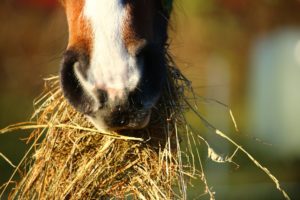 Forage should be the foundation of every equine diet and should be carefully selected to cover as much of the horse’s daily requirements for energy, protein and fiber before a concentrate is even considered.
Forage should be the foundation of every equine diet and should be carefully selected to cover as much of the horse’s daily requirements for energy, protein and fiber before a concentrate is even considered.
Fiber is an energy source that is often overlooked. Digestible fibers (cellulose and hemicellulose within the plant) are broken down by the microbial population in the horse’s hindgut into volatile fatty acids (VFAs) these are then used for energy or stored in the form of fat or glycogen. A portion of indigestible fiber (lignin) is included within the plant but is not useable by the horse. Lignin content increases with maturity and so the more mature a grass/hay is, the less digestible it will be, highlighting the need for careful selection of forages.
A constant forage supply is necessary to keep the microbial population of the gastrointestinal tract working optimally. Limiting or removing forage can result in issues such as colic and gastric ulcers. The average horse will require at least 1.5% of body weight in forage per day. Easy keepers may need a lower percentage where as hard keepers and those in higher demand life stages (such as a lactating mare) may require significantly more.
Forage Types
Forage includes many sources such as pasture, hay (grass and legume) and processed forages. A selection of forage types are available but most commonly horse owners rely on two:
Other forms of forage include processed forages. These include hay cubes, pellets, chaffs, compressed hay flakes/chunks, soy hulls and beet pulp. 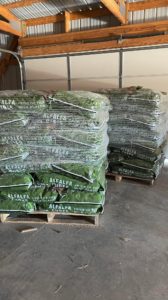 These forage alternatives can help stretch supplies of hay, especially during winter months when additional amounts are being provided in order to help keep horses warm while maintaining condition and can dwindle faster than anticipated. Having a small amount in the diet on a regular basis enables you to increase quickly without having to introduce something new, and so keep this in mind before going into seasons where hay availability may become an issue.
These forage alternatives can help stretch supplies of hay, especially during winter months when additional amounts are being provided in order to help keep horses warm while maintaining condition and can dwindle faster than anticipated. Having a small amount in the diet on a regular basis enables you to increase quickly without having to introduce something new, and so keep this in mind before going into seasons where hay availability may become an issue.
Some chaffs and pellets may even contain a flavoring which will help tempt fussy eaters but watch out for heavily molassed products if you have a horse with issues such as Laminitis, or Cushing’s where sugars need to be monitored.
Dried grass products can be higher in sugars and some products contain added sugars and/or additional grains to increase the energy density of a product. Contact your chosen brand for more information if this is a concern for your horse. Remember that NSC includes sugar and starch, and so even though a product may be advertised as “low sugar” it may still have a high starch content making it unsuitable for some and so be sure to look at the total NSC.
Forage Alternatives
Currently there is no standard marketing for manufactured fiber products and so whether the marketing notes them as a replacer, stretcher or extender they are there to do the same job, to provide additional fiber in the diet.
Fiber is a term referring to a collection of carbohydrates such as cellulose, pectin, and lignin, these fractions exist in pellets, cubes, chaffs just as they do in hay and so it is possible to meet the horse’s fiber need from pellets alone, but not all pellets/cubes are created equal.
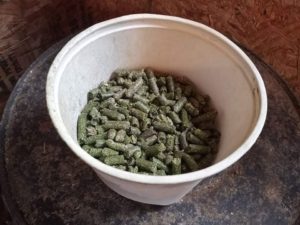 When choosing a forage alternative be sure to look at the crude fiber content and check the ingredients list to ensure that it contains mostly hay. Some cubes can have added ingredients such as grain and thus the fiber portion of these types could be reduced to where it isn’t adequate. Cubes that are mostly hay will have a crude fibre content within the 20-30% range. That being said some complete feeds which may contain levels as low as 18% fiber can still be used as the sole diet as they will also contain additional vitamins and minerals. Another factor to consider is the digestibility of the ingredients included in a forage alternative. For example, alfalfa, timothy hay and soy hulls are highly digestible, whereas rice hulls and peanut hulls will increase the crude fiber value on the label but they are poorly digested by the horse and thus the horse will not gain the same benefit.
When choosing a forage alternative be sure to look at the crude fiber content and check the ingredients list to ensure that it contains mostly hay. Some cubes can have added ingredients such as grain and thus the fiber portion of these types could be reduced to where it isn’t adequate. Cubes that are mostly hay will have a crude fibre content within the 20-30% range. That being said some complete feeds which may contain levels as low as 18% fiber can still be used as the sole diet as they will also contain additional vitamins and minerals. Another factor to consider is the digestibility of the ingredients included in a forage alternative. For example, alfalfa, timothy hay and soy hulls are highly digestible, whereas rice hulls and peanut hulls will increase the crude fiber value on the label but they are poorly digested by the horse and thus the horse will not gain the same benefit.
In general, its preferable that 50% of the horse’s daily forage amount comes from long stemmed hay. Long stemmed forage provides the horse with much needed chew time. Chew time not only mimics the natural feeding behavior of the horse but it also ensures adequate saliva is produced (horses only produce saliva when they chew unlike humans). Salvia helps to lubricate food swallowed and also helps to buffer the stomach acid. The more the horse chews the more saliva is produced and the more acid can be buffered which is ideal for those struggling with gastric ulcers.
Short stemmed and processed fiber feeds take less time to chew which can lead to boredom and stereotypical behaviors.
However, you may be able ti reduce the risk of these issues by:
Although research is still lacking it is thought that long stemmed hay can stimulate the hindgut better than short stemmed hay helping to reduce the risk of colic. Therefore, when selecting a forage alternative it's best to choose one with long coarsely chopped hay rather than fine powders and combining it with some longer stemmed roughage.
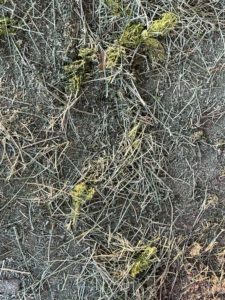
Examples of quids on the floor of a stall.
However, there are situations where long stemmed forage just cannot be utilized. For example, horses with loose, damaged or lost teeth could mean that the horse struggles to chew long stemmed forage such as hay. This is often characterized by “quidding” whereby food is continually dropped from the mouth.
It may be thought that chaffs are the most ideal in these situations as they closely resemble hay but for horses without teeth, cubes and pellets are often easier. This is due to the fact that the fiber length in these are smaller and easier to consume. They also lend themselves to soaking so that the horse can simply slurp it up and swallow. As these horses tend to be unable to consume much grazing (even though they may have their head down nonstop) generally they won’t be gaining much nutritional benefit or consuming as much as you may think. Due to this the water content of their diet can be reduced and so soaking also helps to supply more water.
Horses with issues such as COPD may not be able to consume hay due to its higher levels of dust and spores which can greatly effect such conditions. Steamers are a great option here as they significantly reduce levels of dust and small particles however, they can be expensive and so fiber alternatives can be a great option as they are typically less dusty.
It’s common in the high-performance horse that appetites for larger volume ingredients such as hay dwindle during competitions, and some horses when they are away may also not consume the amount of hay they do at home. Race horses that are fed larger amounts of concentrates may not consume enough hay to ensure an adequate fiber intake. Thus, a forage alternative such as a pellet, cube or beet product may be an ideal way of ensuring adequate fiber intake for the performance horse. Beet products are particularly useful as they can help to add additional water into the diet, ensuring adequate hydration but also since they are a super fiber, they contain more fiber per pound. Meaning that you can feed smaller amounts but get more out which is perfect for horses with small appetites. The other advantage is that they are higher in energy/calories making them ideal for horses that struggle with weight gain as well as performance horses susceptible to conditions such as Tying up or Gastric ulcers. The higher energy/calorie value means that you can replace some or all grain from the diet helping keep conditions at bay without effecting performance or condition. They are also easier and more convenient to transport and store making them ideal for the sports horse.
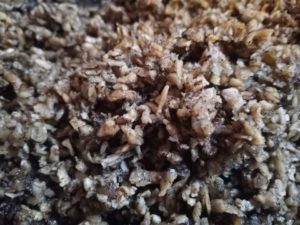
Soaked beet pulp.
When selecting a forage alternative, you may find you need to look for different options based on the condition of the horse. For bad doers looking at fiber sources that contain alfalfa and/or beet products can be helpful as they will provide more calories per pound compared to traditional hays.
Also look for products that contain additional oils as these too will provide more calories to assist in weight gain.
For "good doers/easy keepers" look at perhaps replacing a portion of the forage ration with straw. This can help to keep chew time up whilst lowering calories. Keep in mind that good quality straw must be sourced and avoid this option should your horse struggle with issues such as colic.
Check labels and ensure you choose a product low in calories. Be careful not to assume that low starch/sugar products are also low in calories as often this is not the case as these products will often contain additional oils to replace the starch portion. Forage alternatives such as pellets are quite digestible due to their particle size and you may also find that the quality of hay used is higher than what you would normally feed and thus this could lead to good doers putting on weight, so in the case of the good doer replacing the full amount of forage with a replacer may not be possible.
If you are using a forage alterative as an addition to hay and concentrates, then it’s not vital that the alterative contains a vitamin and mineral pack and could be advantageous in avoiding over fortification. However, if you are feeding it as the sole forage source and/or without additional concentrates, look for one that is fortified or at least consider adding in a balancer to ensure your horse is covered in terms of daily essentials.
When assessing the horses forage intake be sure to weigh everything you feed. Not only will this ensure you are feeding the correct amount but help you to save costs in the long run by reducing issues of over or under feeding. Always feed by weight and not volume, for example a scoop of hay cubes may weigh 2-3lbs, but the same scoop filled with chaff may only hold 1-1.5lbs.
When looking at adding anything new into the diet it’s always worth having the diet assessed by a professional to ensure that everything in the diet remains balanced. Clarity Equine can assist you with this and offer a variety of competitive packages to suit your needs. Contact us at support@clarityequine.com for further info on how we can help you.